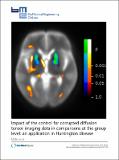Files in this item
Impact of the control for corrupted diffusion tensor imaging data in comparisons at the group level : an application in Huntington disease
Item metadata
| dc.contributor.author | Müller, H.-P. | |
| dc.contributor.author | Kassubek, J. | |
| dc.contributor.author | Grön, G. | |
| dc.contributor.author | Sprengelmeyer, R. | |
| dc.contributor.author | Ludolph, A.C. | |
| dc.contributor.author | Klöppel, S. | |
| dc.contributor.author | Hobbs, N.Z. | |
| dc.contributor.author | Roos, R.A.C. | |
| dc.contributor.author | Duerr, A. | |
| dc.contributor.author | Tabrizi, S.J. | |
| dc.contributor.author | Orth, M. | |
| dc.contributor.author | Süssmuth, S.D. | |
| dc.contributor.author | Landwehrmeyer, G.B. | |
| dc.date.accessioned | 2014-12-01T14:31:13Z | |
| dc.date.available | 2014-12-01T14:31:13Z | |
| dc.date.issued | 2014 | |
| dc.identifier | 158743278 | |
| dc.identifier | 47a9f283-7344-4367-a9b9-a25d516f4102 | |
| dc.identifier | 84910067151 | |
| dc.identifier | 000341738000001 | |
| dc.identifier.citation | Müller , H-P , Kassubek , J , Grön , G , Sprengelmeyer , R , Ludolph , A C , Klöppel , S , Hobbs , N Z , Roos , R A C , Duerr , A , Tabrizi , S J , Orth , M , Süssmuth , S D & Landwehrmeyer , G B 2014 , ' Impact of the control for corrupted diffusion tensor imaging data in comparisons at the group level : an application in Huntington disease ' , BioMedical Engineering Online , vol. 13 , no. 1 . https://doi.org/10.1186/1475-925X-13-128 | en |
| dc.identifier.issn | 1475-925X | |
| dc.identifier.other | ORCID: /0000-0002-3083-5995/work/64697300 | |
| dc.identifier.uri | https://hdl.handle.net/10023/5847 | |
| dc.description | This work was supported by the European Union under the Seventh Framework programme– PADDINGTON Project, Grant Agreement No. 261358, and the European Huntington’s Disease Network (EHDN), project 070 – PADDINGTON. | en |
| dc.description.abstract | Background: Corrupted gradient directions (GD) in diffusion weighted images may seriously affect reliability of diffusion tensor imaging (DTI)-based comparisons at the group level. In the present study we employed a quality control (QC) algorithm to eliminate corrupted gradient directions from DTI data. We then assessed effects of this procedure on comparisons between Huntington disease (HD) subjects and controls at the group level.Methods: Sixty-one HD patients in early stages and forty matched healthy controls were studied in a longitudinal design (baseline and two follow-ups at three time points over 15 months), in a multicenter setting with similar acquisition protocols on four different MR scanners at four European study sites. A QC algorithm was used to identify corrupted GD in DTI data sets. Differences in fractional anisotropy (FA) maps at the group level with and without elimination of corrupted GD were analyzed.Results: The elimination of corrupted GD had an impact on individual FA maps as well as on cross-sectional group comparisons between HD subjects and controls. Following application of the QC algorithm, less small clusters of FA changes were observed, compared to the analysis without QC. However, the main pattern of regional reductions and increases in FA values with and without QC-based elimination of corrupted GD was unchanged.Conclusion: An impact on the result patterns of the comparison of FA maps between HD subjects and controls was observed depending on whether QC-based elimination of corrupted GD was performed. QC-based elimination of corrupted GD in DTI scans reduces the risk of type I and type II errors in cross-sectional group comparison of FA maps contributing to an increase in reliability and stability of group comparisons. | |
| dc.format.extent | 16 | |
| dc.format.extent | 2647964 | |
| dc.language.iso | eng | |
| dc.relation.ispartof | BioMedical Engineering Online | en |
| dc.subject | RC0321 Neuroscience. Biological psychiatry. Neuropsychiatry | en |
| dc.subject.lcc | RC0321 | en |
| dc.title | Impact of the control for corrupted diffusion tensor imaging data in comparisons at the group level : an application in Huntington disease | en |
| dc.type | Journal article | en |
| dc.contributor.institution | University of St Andrews. School of Psychology and Neuroscience | en |
| dc.contributor.institution | University of St Andrews. Institute of Behavioural and Neural Sciences | en |
| dc.identifier.doi | https://doi.org/10.1186/1475-925X-13-128 | |
| dc.description.status | Peer reviewed | en |
This item appears in the following Collection(s)
Items in the St Andrews Research Repository are protected by copyright, with all rights reserved, unless otherwise indicated.

